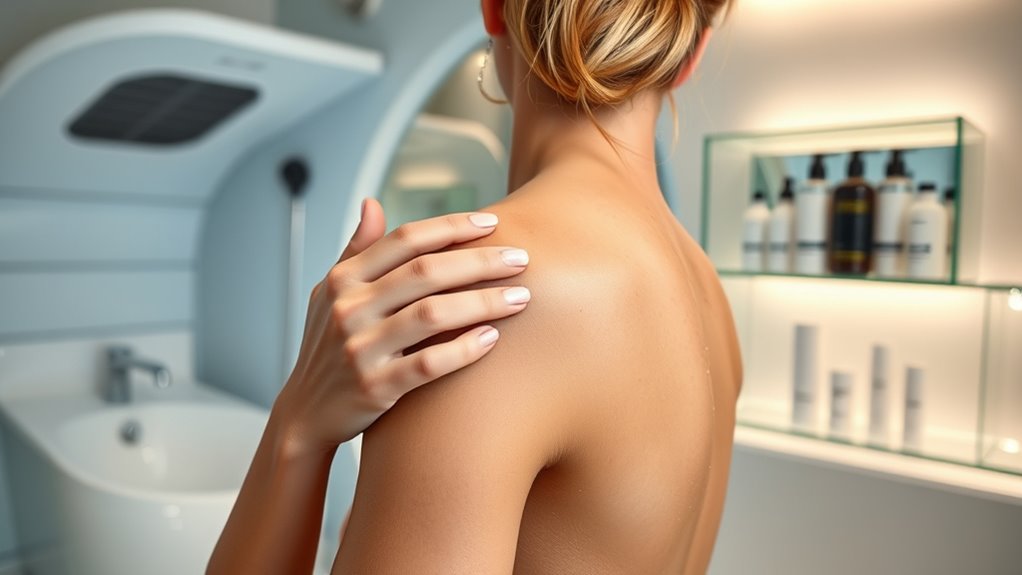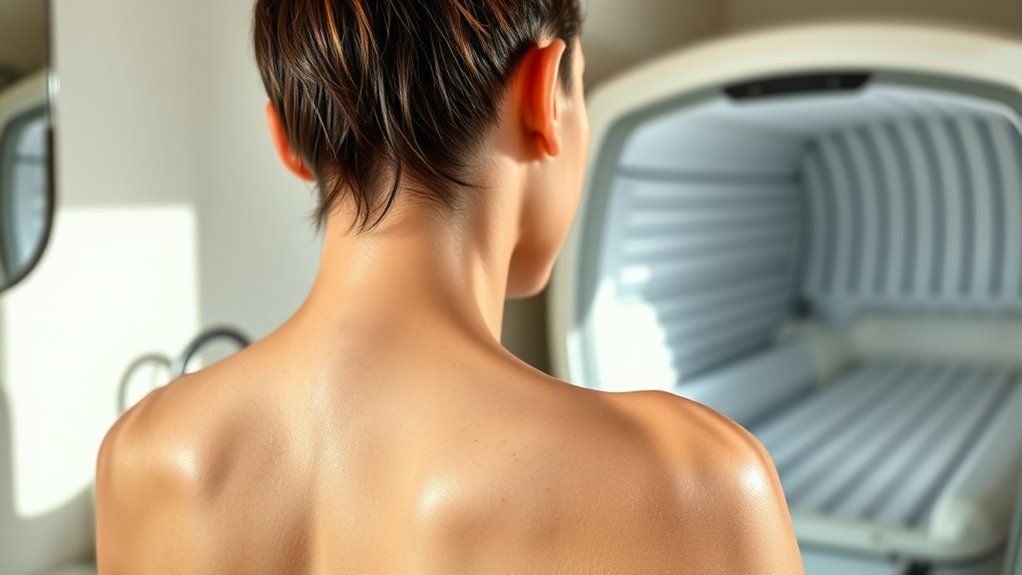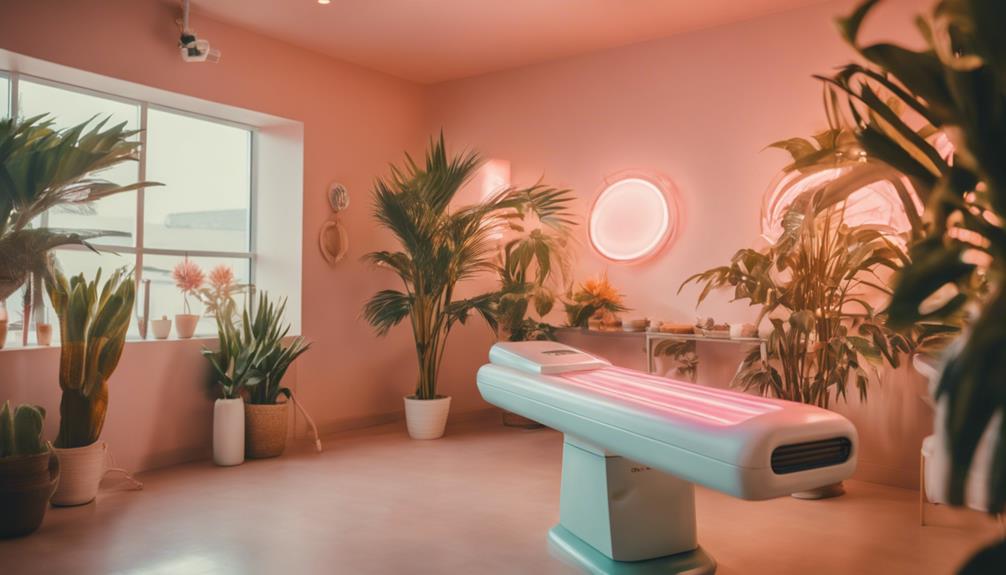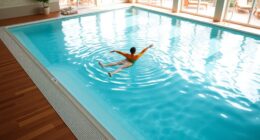To prepare your skin for indoor tanning, start by staying well-hydrated days before your session to keep your skin supple. Exfoliate a day prior to remove dead skin cells for an even tan. Moisturize daily with nourishing ingredients like aloe vera or vitamin E, but avoid heavy creams right before tanning. Protect your skin with broad-spectrum sunscreen on sensitive areas, and begin with shorter sessions if you’re new. Continue exploring for more tips to get the best results.
Key Takeaways
- Hydrate thoroughly in the days leading up to your tanning session to keep skin supple and resilient.
- Exfoliate skin a day prior to remove dead cells for an even, streak-free tan.
- Moisturize daily with nourishing ingredients like aloe vera or vitamin E, avoiding heavy creams immediately before tanning.
- Use broad-spectrum sunscreen on non-tanned areas to protect skin from UV damage during indoor sessions.
- Start with shorter sessions to assess skin response and gradually increase exposure for safe tanning.

Have you ever wondered what indoor tanning involves and whether it’s right for you? If you’re considering giving it a try, understanding how to prepare your skin is essential for a safe and effective experience. Before stepping into the tanning bed, it’s important to focus on UV protection and skin hydration. These two factors play a vital role in minimizing potential damage and maximizing your tan’s longevity.
First, prioritize your skin’s health by ensuring it’s well-hydrated. Drinking plenty of water in the days leading up to your session helps keep your skin supple and resilient. Well-hydrated skin is less prone to dryness and peeling, which can interfere with an even tan. Applying a good moisturizer daily, especially one with nourishing ingredients like aloe vera or vitamin E, helps lock in moisture and creates a smooth surface for tanning. Avoid heavy creams or oils right before your session, as they can clog pores or interfere with the UV absorption process.
Hydrate well and moisturize daily with nourishing ingredients for a smoother, more even tan.
Next, pay attention to UV protection, even before you enter the tanning bed. While indoor tanning is designed for UV exposure, your skin still benefits from a cautious approach. Consider using a tanning lotion that contains skin-nourishing elements, which can help protect your skin’s surface and improve your tan’s quality. Be mindful not to skip moisturizing because dry or damaged skin can be more vulnerable to UV damage. If you have sensitive skin, you might want to consult a professional or opt for a shorter session initially to gauge how your skin reacts.
It’s also wise to exfoliate your skin a day before your session to remove dead skin cells. This step promotes an even tan and prevents patchiness. However, avoid exfoliating immediately before tanning, as fresh, sensitive skin can be more affected by UV exposure. Remember, applying a broad-spectrum sunscreen on areas not intended for tanning or on your lips can provide extra UV protection and prevent unnecessary damage.
Additionally, understanding that air quality can impact your overall health and tanning results is important, especially in environments with pollutants or allergens that could irritate your skin or respiratory system.
Finally, know your limits. If you’re new to indoor tanning, start with shorter sessions and gradually increase exposure. Always listen to your body and stop if you notice redness, discomfort, or dryness. By preparing your skin with proper hydration and UV protection, you’re setting the stage for a safer, more beautiful tan. Taking these steps not only helps safeguard your skin’s health but also enhances your overall tanning experience, making it more enjoyable and less risky.
Frequently Asked Questions
How Long Should I Wait Between Tanning Bed Sessions?
You should wait at least 48 hours between tanning bed sessions to allow your skin to recover and prevent overexposure. This session frequency helps reduce the risk of skin damage and burns. Listen to your skin’s signals—if it feels sore or irritated, give it more time to heal. Regular breaks guarantee your skin stays healthy and maintains a natural glow without unnecessary risks.
Can Indoor Tanning Cause Skin Aging?
Indoor tanning can accelerate skin aging, affecting your skin’s elasticity and increasing wrinkle formation. The UV rays damage collagen and elastin, leading to sagging and fine lines over time. You might notice your skin looking older sooner than expected. To protect your skin’s youthful appearance, limit exposure and consider sunless alternatives. Always use proper skincare to minimize damage and maintain your skin’s health and elasticity.
Are There Any Skin Conditions That Prevent Tanning?
Imagine your skin as a delicate garden, thriving only when conditions are right. If you have skin allergies or infections, the garden’s blooms could wither under the sun’s harsh rays. These conditions can make tanning risky, causing irritation or worsening symptoms. Before you step into a tanning bed, check with your dermatologist to confirm your skin’s health won’t be compromised, keeping your skin’s sanctuary safe and vibrant.
What Should I Do if I Experience a Burn?
If you experience a burn, you should immediately stop tanning and cool the skin with cold water or a damp cloth. Use burn treatment remedies like aloe vera or over-the-counter creams to soothe the area. Keep your skin hydrated by drinking plenty of water and avoid further sun exposure. If the burn is severe, seek medical attention promptly to prevent complications and promote proper healing.
Do Tanning Beds Emit Harmful UV Rays?
Think of tanning beds as mini suns—they do emit UV rays, but they’re more concentrated. This UV exposure can speed up skin damage and increase your risk of skin cancer. While they might seem like a quick way to get a tan, remember, the harm isn’t visible right away. Protect your skin by understanding that tanning beds can pose serious risks due to their UV emissions.
Conclusion
Remember, preparing your skin for indoor tanning is like getting ready for a big event—your effort makes all the difference. I once met someone who skipped the prep and ended up with red, irritated skin, just like a paint job gone wrong. But when you follow these steps, you’re giving your skin the best chance to glow safely, like a well-polished mirror. So, take your time and prep properly—you’ll thank yourself later.









